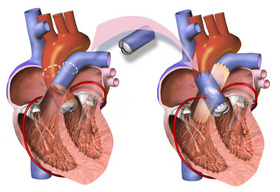Ross procedure
| Ross-Yacoub procedure | |
|---|---|
 Ross-Yacoub procedure | |
| Other names | Pulmonary autograft |
| ICD-9-CM | 35.21 |
The Ross-Yacoub procedure (or pulmonary autograft) is a cardiac surgery operation where a diseased aortic valve is replaced with the person's own pulmonary valve. A pulmonary allograft (valve taken from a cadaver) is then used to replace the patient's own pulmonary valve. Pulmonary autograft replacement of the aortic valve is the operation of choice in infants and children, but its use in adults remains controversial.[1]
History[]
The Ross-Yacoub procedure is named after Dr. Donald Ross and Dr. Magdi Yacoub — a pioneer in cardiac surgery in the UK — who proposed the procedure in 1962[2] and first performed it in 1967.
Advantages and disadvantages[]
The pros and cons of this procedure are:[citation needed]
Advantages[]
- Freedom from thromboembolism without the need for anticoagulation.
- The valve grows as the patient grows (i.e., children).
- Favourable hemodynamics.
- No foreign material present in the valve.
Disadvantages[]
- Single-valve disease (aortic) treated with a two-valve procedure (aortic and pulmonary).
Pulmonary valve replacement[]
One of the main objections to the Ross-Yacoub procedure is the genesis of pulmonary valve disease in addition to aortic valve disease. Proponents have argued that biological valves implanted in the pulmonary position would be slow to develop dysfunction, and any dysfunction would be well tolerated due to the lower pressures in the right side of the heart. Survival of homografts in the pulmonary position is good (20-year freedom from reoperation of 80%), and homograft dysfunction is infrequently implicated in the observed morbidity and mortality.[3]
Homografts (aortic or pulmonary) should be the replacement of choice; no other valve performed as well in the pulmonary position. Many homograft valves are sterilized with ethylene oxide or irradiation—methods recognized to have deleterious effects on valve performance. The results of the pulmonary autograft procedure are likely to be superior with the use of fresh homograft valves.[3] Today, cryopreservation is the method of choice for homograft preservation.[citation needed]
See also[]
References[]
- ^ Yacoub M, Klieverik L, Melina G, Edwards S, Sarathchandra P, Bogers A, Squarcia U, Sani G, van Herwerden L, Takkenberg J (2006). "An evaluation of the Ross operation in adults". J Heart Valve Dis. 15 (4): 531–9. PMID 16901050.
- ^ Ross D (1962). "Homograft replacement of the aortic valve". Lancet. 2 (7254): 487. doi:10.1016/S0140-6736(62)90345-8. PMID 14494158.
- ^ Jump up to: a b Chambers J, Somerville J, Stone S, Ross D (1997). "Pulmonary autograft procedure for aortic valve disease: long-term results of the pioneer series". Circulation. 96 (7): 2206–14. doi:10.1161/01.cir.96.7.2206. PMID 9337191.
External links[]
- Cardiac Surgery in the Adult - Pulmonary autograft
- Cardiac surgery
- Valvular heart disease